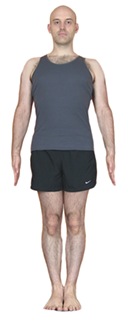Tadasana

Tadasana (
Etymology and origins
Tāḍāsana is from the Sanskrit words ताड tāḍa, "mountain" and आसन āsana meaning "posture" or "seat".[3][4] Samasthitiḥ is from सम sama meaning "equal", level", or "balanced";[5][6] and स्थिति sthiti, "standing".[7]
The pose was unknown in
Description
Tadasana is the basic standing asana on which many other poses are founded. The feet are together and the hands are at the sides of the body. The posture is entered by standing with the feet together, grounding evenly through the feet and lifting up through the crown of the head. The thighs are lifted, the waist is lifted, and the spine is elongated. The breathing is relaxed.[9] It is used in some schools of yoga in between other poses, to allow the body and consciousness to integrate the experience of the preceding asana and to prepare for the next.[10]
Variations

Placing the feet wider is common in vinyasa styles of yoga and provides a more stable base in this and other such standing asanas.[11]
Namaskarasana,
Pashchima Namaskarasana or Reverse Prayer Pose has the hands in prayer position behind the back.[12]
Urdhva
Parshvasana (Side Stretch Pose), also called Indudalasana, known from 1968, has the arms lifted and the body stretched over to one side.[14][15]
Anuvittasana or Hasta Uttanasana (Standing Back Bend), has the arms raised and the back arched.[16] An extreme form of the pose is Tiryang Mukhottanasana, in which the back bend is sufficient to enable the hands to grasp the ankles.[17]
Some reclining asanas such as Supta Tadasana (Reclined Mountain Pose) stem from Tadasana.[18]
Iyengar Yoga
Iyengar Yoga considers Tadasana pivotal as the foundation of most standing asanas. It teaches practitioners to balance the weight equally on the two feet.The feet are placed together, the shins and thighs are aligned, and the chest is lifted.[19] The pose is not distinguished from Samasthitih. The arms can be raised over the head or kept at the sides of the legs.[9] It appears in the 1st and 2nd weeks of Iyengar's āsana courses as detailed in Light on Yoga.[20][21]
Ashtanga Vinyasa Yoga
In
See also
References
- ^ "Yoga Journal - Mountain Pose". Retrieved 11 April 2011.
- ISBN 978-81-86336-14-4.
- ^ Ranjini 2012, p. आसन entry.
- ^ Sinha 1996, p. 18.
- ^ Ranjini 2012, p. समा entry.
- ^ a b Steiner 2012, p. Samasthitih.
- ^ Ranjini 2012, p. स्थिति entry.
- ISBN 81-7017-389-2.
- ^ a b Iyengar 2005, p. 41.
- ^ Fitz-Simon 2010, p. Standing Poses: Tadasana (Mountain Pose).
- ^ Kaminoff 2007, p. 39.
- ^ a b Ramaswami 2005, p. 3.
- ^ Steiner 2012, p. Urdhva Vrikshasana.
- ^ Majumdar, Sachindra Kumar (1968). Yoga for physical and mental fitness. Stravon Educational Press. p. 80.
- ^ Rhodes, Darren (15 February 2013). "Yoga Sequence for Change: 5 Steps to Parivrtta Paschimottanasana". Yoga Journal. Retrieved 8 February 2019.
- ^ Kline, Sarah. "Standing Back Bend • Anuvittasana". Yoga Today. Retrieved 8 February 2019.
- ISBN 978-0-8348-4124-6.
- ^ Fitz-Simon 2010, p. Supta Tadasana.
- ISBN 81-87603-01-1.
- ^ Iyengar 2005, p. 131 (Appendix: āsana courses).
- ISBN 0-679-72287-4.
- ^ a b c Ramaswami 2005, p. 1-34.
- ^ Maehle 2011, p. 880.
- ^ Ramaswami 2005, p. 2.
Sources
- ISBN 978-81-7223-606-9.
- Sinha, S. C. (1996). Dictionary of Philosophy. Anmol Publications. ISBN 978-81-7041-293-9.
- ISBN 978-0-7360-6278-7.
- ISBN 978-1-56924-402-9.
- Maehle, Gregor (2011). Ashtanga Yoga Practice and Philosophy. ISBN 978-1-57731-986-3.
- Steiner, Ronald P. (2012). "AshtangaYoga.info".
- Ranjini, V. V.; et al. (2012). "SpokenSanskrit Dictionary".
- Fitz-Simon, Witold (2010). "Yoga Art and Science".


